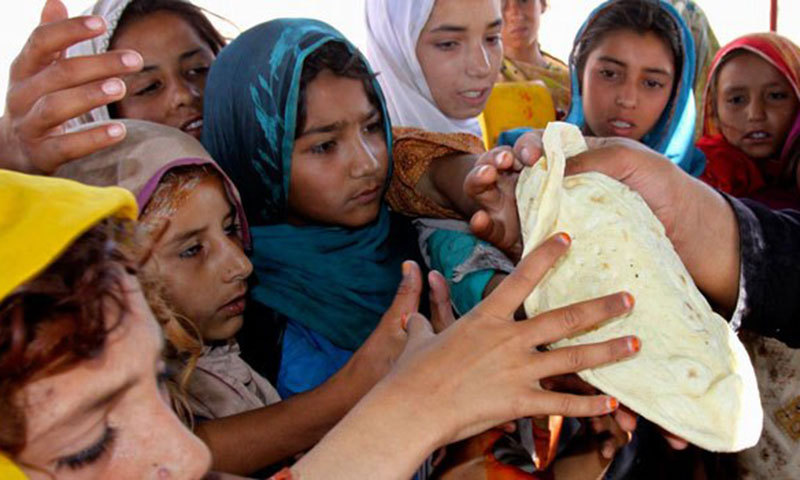
As Pakistan wrestles with a multifaceted economic crisis, one silent but deeply consequential issue continues to fester — food security.
While official data showed that food inflation fell to 0.3% by December 2024, the statistic belies a far grimmer reality on the ground.
For millions of Pakistanis, access to food remains out of reach, not because of high prices alone, but due to persistent poverty, joblessness, and structural inequities.
This dichotomy between economic data and lived experience exposes the limitations of viewing food security through a narrow inflationary lens.
While a decline in food inflation might suggest a reprieve for households, it does not automatically translate into food availability or affordability for the poor.
In Pakistan’s case, low food inflation masks deeper vulnerabilities that are now threatening to push the country into a full-blown hunger crisis.
The illusion of stability
At first glance, the reported decline in food inflation offers hope.
After a turbulent 2023 marked by devastating floods, IMF-driven austerity, and currency depreciation, any sign of macroeconomic stabilisation is welcome.
However, this stabilisation has yet to improve the economic fortunes of ordinary citizens.
In rural areas, where the majority of Pakistan’s poor reside, access to essential food items remains erratic.
Urban slums, on the other hand, continue to grapple with chronic underemployment and soaring living costs that neutralise any gains from reduced food price growth.
The issue here is twofold.
First, food prices are stabilising from an already inflated base. Between mid-2022 and mid-2024, Pakistan saw food prices surge as much as 30–40% for key staples like wheat, rice, and cooking oil. A marginal decrease in inflation at the tail end of 2024 does not undo this cumulative price hike.
Second, the metric of food inflation does not account for reduced purchasing power, joblessness, and income stagnation — all of which remain severe and entrenched.
Poverty, unemployment, and the right to eat
At the heart of the food security crisis is the harsh economic reality that millions of Pakistanis face each day.
According to the World Bank, over 39% of the population now lives below the poverty line.
Youth unemployment is at a record high, and a swelling informal economy fails to provide steady incomes or social protections. For the average Pakistani, the challenge is not whether food is cheaper than last year, but whether there is enough money to buy it at all.
Food security is fundamentally about access. Even when markets are stocked, the poor often cannot afford sufficient or nutritious food.
This is especially true for households that depend on daily wage labour, remittances, or unstable agricultural incomes.
In many parts of Balochistan and interior Sindh, reports suggest that malnutrition rates are on the rise, particularly among children.
Stunting, wasting, and micronutrient deficiencies are increasing — an ominous sign of long-term developmental damage.
Meanwhile, food insecurity in Pakistan is increasingly gendered.
Women and girls are often the first to reduce their food intake when resources run short.
In conservative and impoverished households, this silent sacrifice goes unnoticed and unrecorded, yet its cumulative toll is devastating — on maternal health, education, and workforce participation.
Fragile supply chains and climate vulnerability
The situation is further complicated by Pakistan’s vulnerability to climate shocks and a fragile agricultural supply chain.
Floods in 2022 and erratic weather patterns in subsequent seasons have disrupted crop cycles and reduced yields.
Wheat, a dietary staple, saw significant losses due to unseasonal rains and pest outbreaks. The result has been localised scarcities, logistical bottlenecks, and price spikes that ripple across regions.
Pakistan’s agriculture sector remains critically under-mechanised and dependent on outdated irrigation methods.
Smallholder farmers, who constitute the majority of cultivators, lack access to credit, storage, and markets.
Post-harvest losses remain high, and government procurement policies are often riddled with inefficiencies or outright corruption. In this context, even good harvests may not guarantee food security for the nation.
To make matters worse, cross-border tensions and internal security concerns continue to disrupt food transport, particularly in restive areas of Khyber Pakhtunkhwa and Balochistan.
In such environments, accessibility becomes as pressing a concern as availability.
A crisis hidden in plain sight
Perhaps what makes Pakistan’s food insecurity crisis more insidious is its invisibility.
Unlike famine or acute shortages that trigger international alarm, Pakistan’s crisis is chronic and systemic.
It manifests in quiet, unseen ways — empty lunchboxes in schoolbags, skipped meals at dinner, undernourished children failing to thrive.
The official data may not reflect these realities, but they are deeply embedded in the fabric of everyday life for millions.
Public discourse and media coverage have also been erratic.
Political crises, judicial drama, and foreign policy flare-ups tend to dominate headlines.
Meanwhile, food insecurity — an issue that directly affects national stability, human development, and social cohesion — receives far less sustained attention.
This lack of visibility contributes to policy inertia and delayed responses at both federal and provincial levels.
Social tensions and political ramifications
As economic discontent grows, the link between food insecurity and political instability cannot be ignored.
Hunger breeds desperation, and desperation often translates into unrest.
In 2023 and early 2024, several cities witnessed sporadic protests over wheat shortages, flour prices, and delays in ration distribution.
While these incidents were localised, they reflect a broader sense of frustration and alienation that could deepen if the food situation worsens.
Moreover, with general elections on the horizon, food security is likely to become a contentious political issue.
Competing parties may weaponise food distribution as a campaign tool, leading to politicisation rather than depoliticisation of hunger.
Short-term fixes may be favoured over structural reforms, especially in politically sensitive regions.
Religious charities and NGOs have stepped in to fill the void left by the state, but their reach is limited and inconsistent. Relying on ad hoc welfare in a nation of over 240 million people is neither sustainable nor just.
Pakistan stands at a precarious juncture.
While headline economic indicators may suggest stabilisation, the lived experience of millions tells a different story — one of hunger, uncertainty, and unrelenting hardship.
Food insecurity in Pakistan is not simply about inflation or supply chains; it is about poverty, inequality, and structural neglect.
The crisis may be slow-burning, but its consequences will be long-lasting if left unaddressed.
Until food is treated not as a commodity but as a right — intertwined with employment, dignity, and equity — the country’s long-term stability and development will remain under threat. For now, the silent hunger of the nation continues to grow, demanding more than economic statistics to understand, and far more political will to confront.






